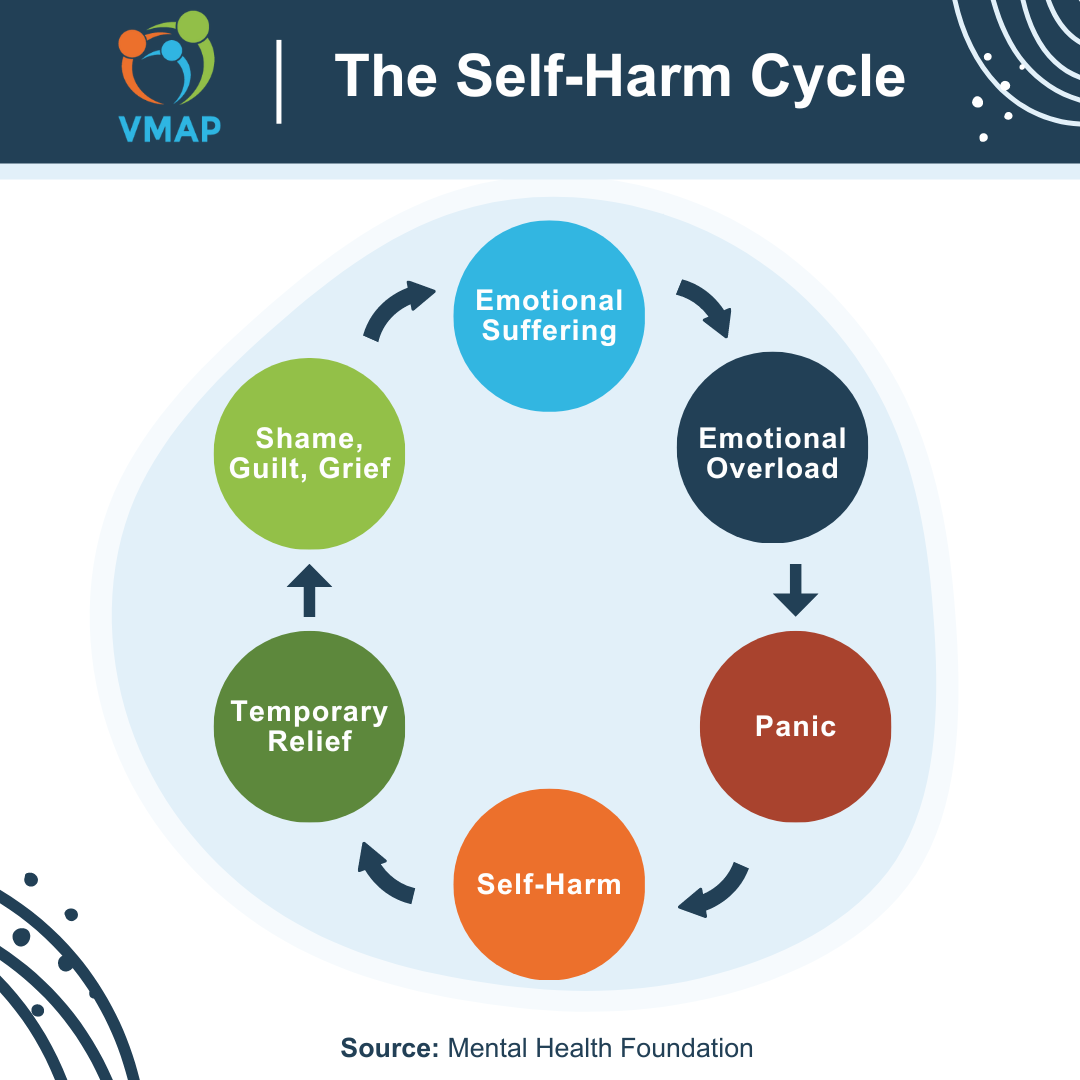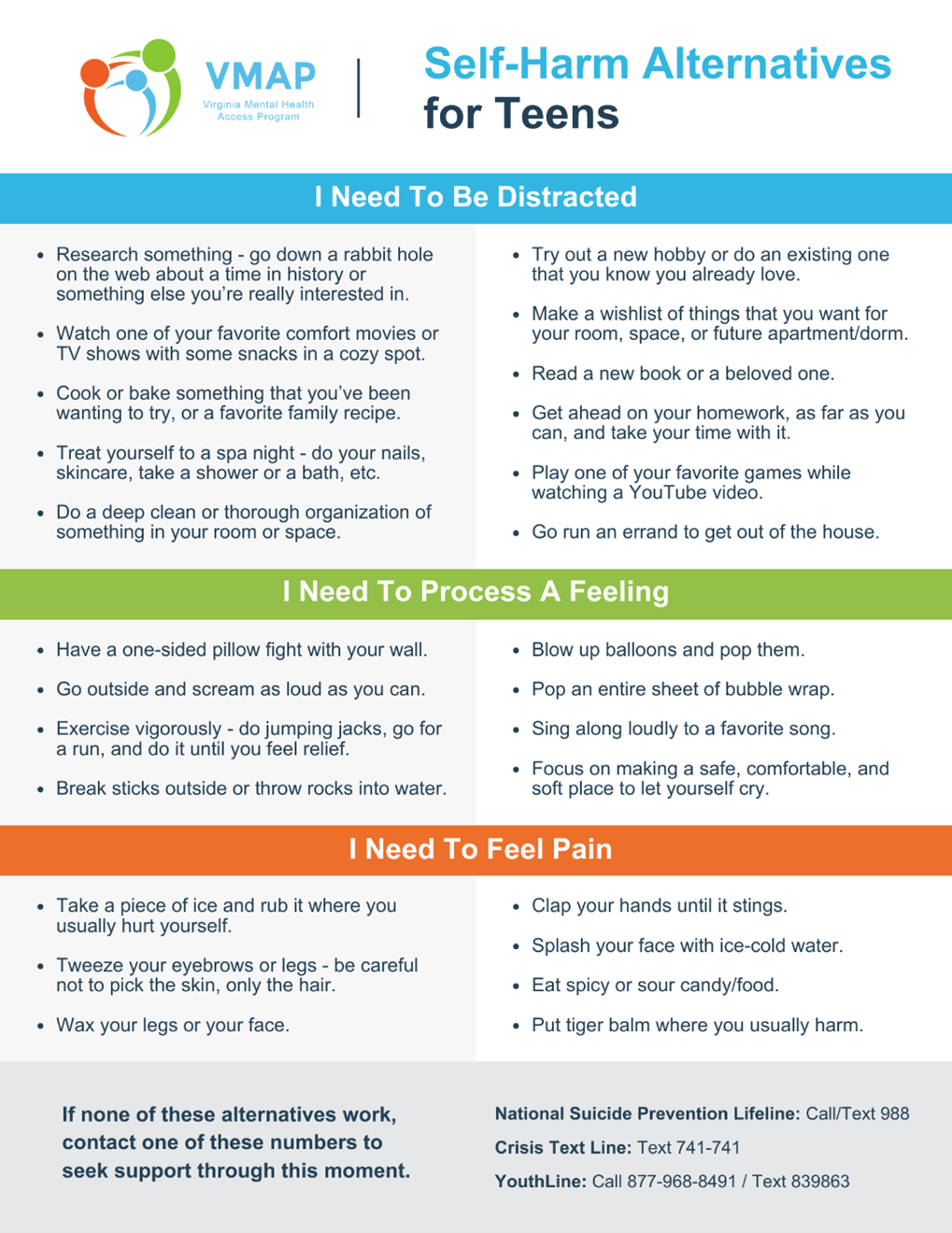How to Help Your Teen Stop Self-Harming
Please Note: Self-harm is a triggering and upsetting subject for many, so make sure you are prepared to learn more about it. If you find yourself in a mental health crisis and need additional support, call or text the National Suicide Prevention Lifeline at 988, or text Crisis Text Line at 741-741.
If you are concerned about your teen, please reach out to their pediatrician to discuss the best plan on how to approach this sensitive topic with them.
No parent ever expects their child to hurt themselves intentionally, and most are understandably not prepared for a situation as shocking and stressful as this. We hope this article will help parents across Virginia have a better understanding of the following:
- How common self-harm is among teens
- Why teens might self-harm
- Warning signs of self-harm in teens
- How you can support teens who self-harm
- Self-harm alternatives for teens
Before we begin, we want to express the importance of speaking with your teen’s pediatrician when you have concerns about their mental health, especially when it’s connected to something as serious as self-harm. If your pediatrician isn’t certain of resources or referrals, let them know that they can contact the VMAP Line to connect with a consulting child psychiatrist. This psychiatrist will talk through your teen’s situation with their pediatrician and offer support that will help you and your teen in turn.
Prevalence of Self-Harm in Teens
With an overall rate of 18% in teens, the prevalence of self-harm differs by multiple factors. This includes race, ethnicity, gender/sexual identity, and what state you live in. For example, it’s much more common in girls than it is in boys, with 1 in 4 teen girls having deliberately harmed themselves in the last year, in contrast to 1 in 10 teen boys. Researchers have also found that having depression, suicidal thoughts, experiencing bullying, smoking, substance use, or being part of the LGBTQ+ community significantly raises the likelihood that a teen will harm themselves. Self-harm is also associated with an increased risk of suicide, with up to 70% of teens who self-harm also making a suicide attempt, and 55% making multiple attempts. While this doesn’t mean that a teen who is self-harming is necessarily considering suicide, the association between the two makes it even more important to address the discovery of self-harm with the right intervention and support.
Why Teens Self-Harm
If you are unfamiliar with the reality of self-harm, you may have heard that it’s just a “phase” that teens go through, or that they’re “doing it for attention”. On the contrary, most teens carry out self-harm due to one of the following reasons:
- Trying to cope with strong and upsetting emotions that they don’t know how to manage on their own, such as tension, anxiety, sadness, frustration, anger, or panic
- Using physical pain to distract from emotional pain
- Trying to gain control over problems, pressures, or feelings they’re experiencing
- Trying to stop feeling numb or shut down—they want to “feel something”
- Trying to punish themselves for being a “burden” or committing a perceived wrong
- They feel they deserve to hurt, feel pain, and suffer
While it might seem counter-intuitive, self-harm brings some sense of relief in the moment. As you can imagine, this is only a temporary (and negative) solution for teens.

The feelings that self-harm resolves eventually return, and so does their urge to hurt themselves. This vicious, painful cycle continues to repeat and becomes a habit that feels impossible to break.
Warning Signs of Self-Harm in Teens
Warning signs of self-harm can be diverse and easy to miss, even for the most involved parents. To help, we have compiled a list of both subtle and overt warning signs of self-harm you may see in teens.
- Unexplained physical injuries of any kind, including more unexpected ones like burns, bruises, and bald spots.
- Seeming low, depressed, withdrawn, or hopeless; suddenly prone to out-of-character irritability, anger, or other outbursts.
- Keeping themselves covered, even during hot weather.
- Avoiding situations where skin is revealed, such as swimming or changing in a locker room.
- Changes in eating and/or exercising habits.
- Spending long periods of time alone, often in the bathroom or bedroom.
- Increased isolation and social withdrawal.
As a parent, you know your teen best. If you have a suspicion or a gut instinct that they might be hurting themselves, it’s time to step in and support them. We’ve created the following guide to help you feel more prepared, from having that first hard conversation to supporting them in their recovery.
Parents Guide: Support Teens Who Are Self-Harming
- Start the Conversation When You Notice a Warning Sign
When you notice a warning sign of self-harm in your teen, you might want to confront them immediately, but experts recommend letting teens know in advance that you want to talk to them about something important and set an expectation for how long it will take. For example, you might say: “Hey, I want to talk to you about your mental health and how you’re doing. I think it might take a little bit, maybe 30 minutes or so. Do you want me to come get you after dinner and we can go for a drive or a walk, or would you rather come to my room and find me later tonight?”
Regardless of how well you prepare yourself and your teen, it may be an uncomfortable and emotional conversation. To help moderate this, try and stay as calm as possible during the talk. As painful as it is to find out that your teen is hurting themselves, showing your frustration, anger, panic, or upset in front of them is more likely to hurt rather than help.
To achieve this state of calm, lead this conversation with your love and concern for them, rather than accusations. You can start by saying something like:
- “I’ve noticed that you haven’t seemed like yourself lately, and I’m worried that you might be hurting yourself. I’m here to support you no matter what, and I want to check in and see how you’re doing.”
- “I’ve noticed [warning sign] and I’m worried that you’ve been hurting yourself. I’m here for you and I want to support you—what’s going on?”
Be prepared for resistance, denial, and anger. If this is the case, let your teen know that you can have this conversation again when they’re feeling calmer. There will be another time to communicate—don’t force them to talk when they’re not ready. Lastly, make sure to listen more than you speak. This isn’t a time to be “right” or “teach them a lesson”—it’s just a time to be there as best you can.
Need guidance before starting this conversation? Reach out to your teen’s pediatrician or Primary Care Provider.
- Get Professional Help for Your Teen
At this point, you’ve had the initial conversation and you’re figuring out how to keep your teen safe, but it’s time to get professionals involved. Tell them you’re going to schedule an appointment with their pediatrician to get more support for both of you, but you will make sure they have time to speak with their doctor privately. During this appointment, make sure to ask the following questions, along with any others you have.
- “Do you have any referrals for local therapists and psychiatrists that specialize in child mental health?”*
- “What would you recommend in terms of a ‘safety plan’ for us when my teen tells me they’re thinking about hurting themselves, or they’ve already done so?”
- “How would you recommend we keep our home safer for my teen?”
* If your pediatrician is unsure, let them know they can utilize the VMAP Line and get connected to a consulting child psychiatrist to discuss your teen’s case and get additional resources. You can also use a search engine like Psychology Today to find therapists who work with teens and specialize in self-harm.
- Maintain Open Communication with Your Teen
Maintaining communication with your teen about their mental health and self-harm can certainly be challenging, but it’s not impossible! Experts recommend putting some kind of system in place, like “traffic lights”, to help your teen ask for support on their terms. For “traffic lights”, each color has a different meaning and solution. When used for self-harm, it might look like:
- Green: low risk of self-harm; doing okay. No support needed.
- Yellow: some risk of self-harm; feeling stressed. Need a hug, no questions asked.
- Red: at risk of self-harm; feeling overwhelmed. Need to do something distracting together, like watching a movie, running an errand, or playing with a pet.
Establishing this system or a similar one should be a collaborative effort with your teen. Work with them to decide what each color means and what support they need for them. Once this foundation is in place, it makes it much easier to initiate conversations about self-harm or other difficult topics as they arise. You might also establish regular check-ins with your teen, where you take them out for a treat once a week, then sit and chat about how they’re doing. The most important thing in all of this is making sure that your teen is comfortable with it, and you’re doing it in a way that works for them!
4. Suggest Self-Harm Alternatives
Another way you can support your teen in their ongoing recovery from self-harm is to have a list at hand of self-harm alternatives. There are a wide variety of distractions to choose from, all depending on what your teen needs in that moment.
We’ve created this printable resource to give you and your teen a starting point for self-harm alternatives.
We recognize this is a lot of information, and we hope at least some of it has been helpful for your situation. Remember to prioritize connecting with your pediatrician about your teen’s situation, and don’t hesitate to reach out for the support you need.
If it ever feels like too much to handle, reach out to one of the resources below, so you can continue to be there for your teen.
- National Suicide Prevention Lifeline: call or text 988
- Crisis Text Line: text 741-741
- Mental Health America of Virginia: call 1-866-400-6428

